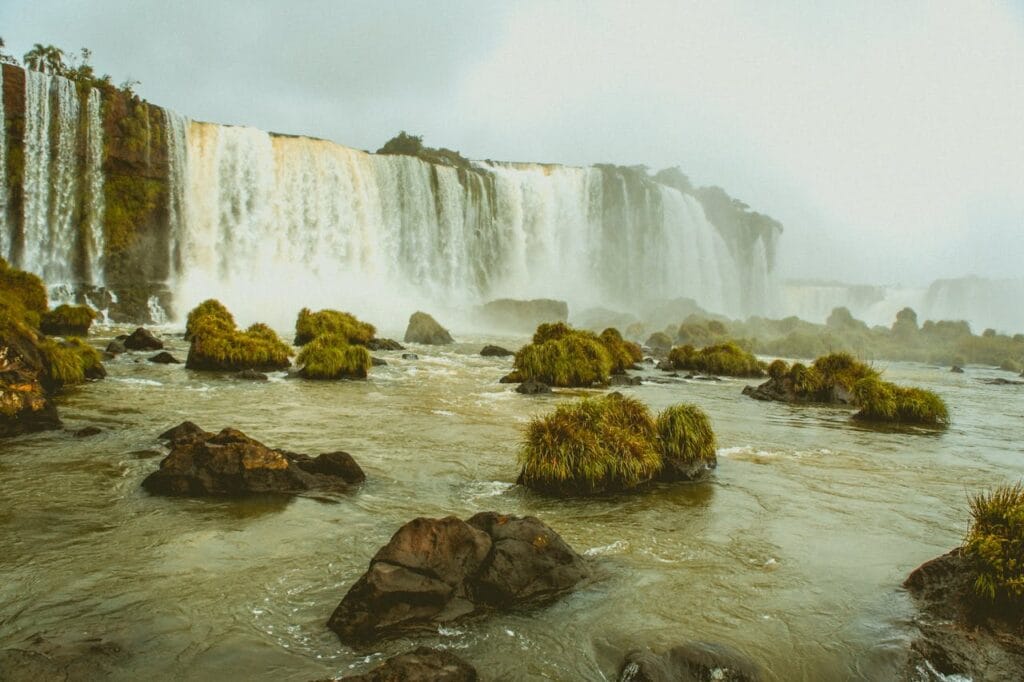
Iguazu Falls is a destination you visit with high expectations, already knowing you’ll encounter something extraordinary. However, when you arrive, the reality far exceeds anything you could have imagined. You’re taken aback by the overwhelming power and vastness of the place.
Many people are moved by the sheer beauty, while others find themselves reflecting on nature and life. But everyone shares the feeling of wonder when standing before one of the most breathtaking natural wonders on the planet.
It’s often said that Iguazu Falls is a must-see destination for nature lovers and adventure seekers. However, I believe it’s a place for everyone. It’s a destination that anyone who has the opportunity should visit.
In this Iguazu Falls Travel Guide, I’ll provide a general overview with all the essential information for a trip to Iguazu Falls, covering both the Brazilian and Argentine sides.
So, let’s begin.

Iguazu Falls is one of the most amazing natural sights in the world, located on the border between Brazil and Argentina.
The falls are part of the Iguazu River and spread across a large area with 275 different waterfalls, stretching for 2.7 kilometers (1.7 miles) and having a drop height of between 64 and 82 meters (210 and 269 feet).
The falls are surrounded by the dense, green Atlantic Rainforest, making the area not only beautiful but also an important habitat for wildlife and plants.
The name “Iguazu” comes from the local Guarani language, meaning “big water,” which describes the massive amount of water that flows through the falls.
The falls are split between Iguaçu National Park in Brazil and Iguazú National Park in Argentina, both protected areas that are recognized by UNESCO as World Heritage Sites.
The most famous part of Iguazu Falls is the Devil’s Throat (Garganta do Diabo), where the water drops 82 meters (269 feet) into a deep canyon.
The sight and sound of the water crashing down here are truly impressive, and you can see the mist rising from the falls from far away.
In addition to the waterfalls, the area is full of wildlife. The surrounding parks are home to many animals, including birds, butterflies, mammals, reptiles, and other species.
Where are the Iguazu Falls?

Iguazu Falls is located on the border between two South American countries, Brazil and Argentina, within the Atlantic Rainforest. The falls are shared between Iguaçu National Park in Brazil and Iguazú National Park in Argentina.
While the Iguazu River forms the natural boundary between Brazil, Argentina, and Paraguay, the falls themselves are not located in Paraguayan territory.
On the Brazilian side, Iguazu Falls is found in the state of Paraná, with the city of Foz do Iguaçu serving as the main hub for tourists. This city offers easy access to the falls, as well as numerous hotels, restaurants, and transport services.
Across the border, on the Argentine side, the falls are located in the province of Misiones, near the town of Puerto Iguazú, another key starting point for visitors exploring the area.
Despite being close to Paraguay, with the confluence of the Iguazu and Paraná Rivers forming part of the natural boundary between the three countries, the falls do not extend into Paraguayan territory.
However, the nearby city of Ciudad del Este in Paraguay is a short drive away and part of the tri-border region, which many tourists visit while in the area.
👉 Book your stay in Foz do Iguaçu with ease: Hoteis.com has great hotel options, and Hostelworld lists the best hostels in town.
Sign up Now for the Best Travel Tips exploring Brazil!
Get expert travel tips, detailed itineraries, and insider recommendations for your trip.
When is the Best Time to Visit Iguazu Falls?
When planning a trip to Iguazu Falls, each season offers its own unique experience:
- Summer (December to March): This is the wet season, when the falls are at their most powerful and dramatic due to frequent rain, which significantly increases the water flow. The falls are truly impressive during this time, but the weather can be very hot and humid, with average temperatures between 25°C and 35°C (77°F to 95°F). Be prepared for afternoon thunderstorms, which are common during the wet season.
- Autumn (April and May): The weather becomes milder, with average temperatures ranging from 18°C to 25°C (64°F to 77°F). There are fewer rainy days compared to summer, but occasional showers ensure the water flow remains strong. This season offers a pleasant balance of cooler temperatures and impressive water levels.
- Winter (June to August): This is the dry season, with cooler temperatures and lower water flow. Average temperatures range from 10°C to 23°C (50°F to 73°F). While the falls may lose some of their dramatic intensity, the lower volume of water allows for clearer views of the individual cascades, especially the Devil’s Throat.
- Spring (September to November): As temperatures rise again, cold fronts bring more rain, which increases the water flow. The weather is generally pleasant, with average temperatures between 17°C and 28°C (63°F to 82°F). The falls regain their fuller and more powerful appearance as the rainy season approaches.
In terms of the number of tourists, the parks receive visitors year-round, but certain times are busier than others. The local holiday months—July, December, and January—as well as public holidays, attract the most tourists. If you’re looking for fewer crowds, weekdays, especially Mondays and Tuesdays, tend to be quieter.
For the best experience during the day, it’s recommended to visit early in the morning or later in the afternoon, as these are the times when the parks are less crowded. According to the official Instagram page of the Brazilian side of the park, the quietest times are between 9 AM and 9:30 AM and from 2 PM to 4 PM.
For a more peaceful and unique experience, you can book exclusive packages that allow you to visit the falls during sunrise or sunset, when the parks are less crowded.
Additionally, there’s a full moon tour, which offers a magical and serene experience under the moonlight—perfect for those looking to avoid the daytime rush.

How Do You Get to Iguazu Falls?
As mentioned above, there are two cities where you can stay to visit Iguazu Falls: Foz do Iguaçu on the Brazilian side or Puerto Iguazú on the Argentine side. Both are well connected by flights and buses within their respective countries.
Brazilian Side:
The main gateway for tourists in Foz do Iguaçu is Foz do Iguaçu International Airport (IGU), located just 4 km from the entrance of Iguaçu National Park and 14 km from the city center of Foz do Iguaçu.
The airport is connected to several major Brazilian cities such as São Paulo, Rio de Janeiro, Curitiba, Florianópolis, and Belo Horizonte, with flight durations ranging from about 1 to 2 hours.
From the airport, you can reach your hotel or the park via Uber, taxi, transfer services, local buses, or rental cars.
If you’re traveling by land, you can also drive to Foz do Iguaçu or take long-distance buses from cities like São Paulo or Rio de Janeiro. However, the bus journey is quite long: it takes around 16 hours from São Paulo and 25 hours from Rio de Janeiro.
While staying in Foz do Iguaçu, you can reach the Brazilian side of the park by Uber, taxi, local bus, tour/transfer services, or rental car.
👉 Need internet while crossing borders? Airalo is a top-rated eSIM provider — easy to set up, reliable, and perfect for travelers visiting both Brazil and Argentina. Check Airalo here.
Argentine Side:
On the Argentine side, the Cataratas del Iguazú International Airport is located 25 km from the center of Puerto Iguazú and 10 km from Iguazú National Park.
It’s connected by direct flights to major Argentine cities like Buenos Aires (about a 1 hour and 45-minute flight), Salta, and Córdoba.
In Puerto Iguazú, you have four transportation options from the airport to the city center: local buses (Rio Uruguay), shared van services, taxis/transfers, or rental cars.
Just like in Brazil, you can also reach Puerto Iguazú by rental car or long-distance bus. A bus trip from Buenos Aires takes approximately 18 hours.
In Puerto Iguazú, you can get to the Argentine side of the park by taxi, local bus, tour/transfer services, or rental car.
What to Do at Iguazu Falls?
Brazilian Side
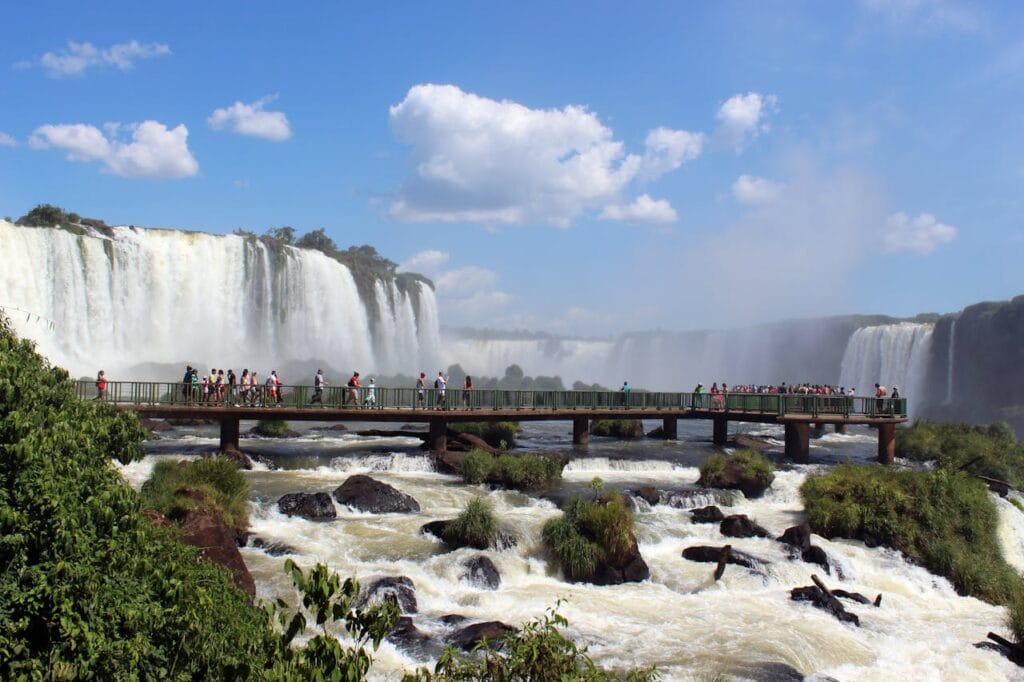
A visit to the Brazilian side of Iguazu Falls offers a diverse range of experiences, from panoramic views of the falls to activities in the surrounding rainforest. Here’s an overview of what you can expect:
Basic Visit to Iguaçu National Park (2-3 Hours)
A standard visit to Iguazu National Park typically lasts 2 to 3 hours, and includes the following:
- Shuttle Ride: After entering the park, visitors take a shuttle bus that stops at various points, including the entrance to the main trail.
- Waterfalls Trail: The Waterfalls Trail on the Brazilian side of Iguazu Falls offers one of the most stunning panoramic experiences in Iguaçu National Park. This 1.5 km (0.9 miles) trail provides breathtaking views of the falls from various angles as you walk along a well-maintained pathway.
- The trail begins with distant views and gradually brings you closer to the falls, showing you the full size and beauty of Iguazu. The main highlight is the viewing platform at Devil’s Throat (Garganta do Diabo), where you can feel the mist on your face and see the powerful water crashing into a deep gorge. The sound of the falls and the sight of the water make it a truly unforgettable experience.
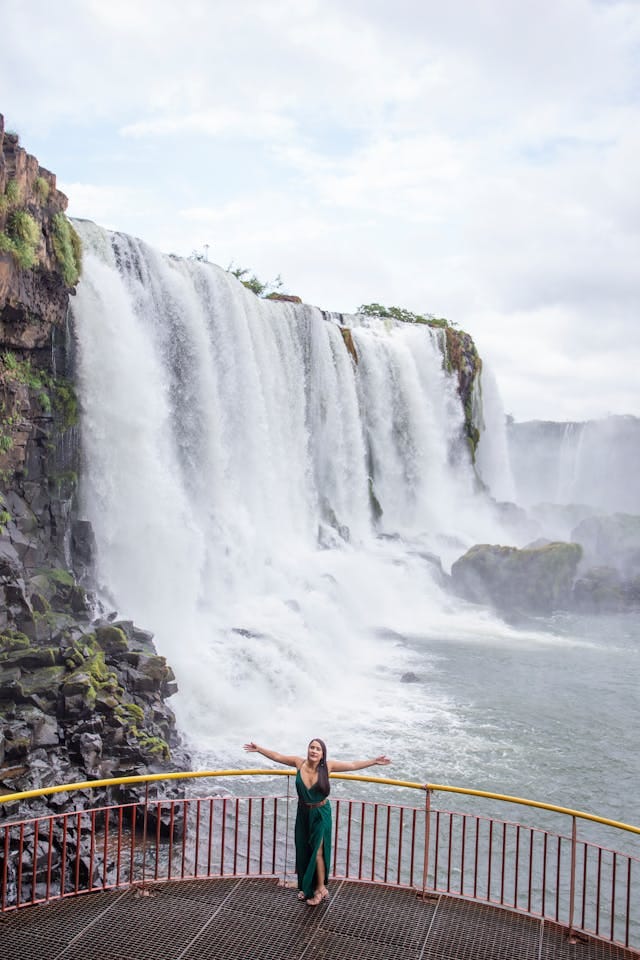
Macuco Safari Boat Ride (2 Hours)
For those seeking adventure, the Macuco Safari is a boat ride that takes you directly to the base of the falls. This experience includes:
- Jungle Ride: Start with a 2 km (1.4 miles) electric jeep tour through the Atlantic Rainforest, where you’ll spot wildlife and learn about the ecosystem. This part of the tour lasts about 20 minutes.
- Short Hike: Afterward, you’ll hike 600 meters (roughly 10-15 minutes) to reach the dock, where you’ll find a small souvenir shop, restrooms, and lockers for convenience during the trip.
- Boat Ride: The real adventure begins with a 25-30 minute boat ride that takes you under some of the smaller waterfalls. You can choose between two options: with excitement (the boat gets closer to the waterfall, and everyone gets soaked) or without excitement (the boat stays at a safe distance from the falls, and no one gets wet).
- If you choose the “with excitement” option, make sure to bring dry clothes, because it’s impossible not to get soaked (even with a raincoat).
👉 Discover the Brazilian side of Iguazu Falls comfortably — this tour picks you up from your hotel and includes the Macuco Safari boat ride.

Helicopter Ride Over Iguazu Falls (10-15 Minutes)
For a bird’s-eye view of the falls, the helicopter ride is a must-do experience. Departing from a nearby heliport, this 10 to 15-minute flight provides a breathtaking aerial perspective of the entire Iguazu Falls system, as well as the surrounding rainforest. It’s the perfect way to capture the vastness of the falls and see areas that are inaccessible from the ground.
However, it’s important to note that this tour is criticized by conservationists, as it disturbs wildlife and has even been banned on the Argentine side.
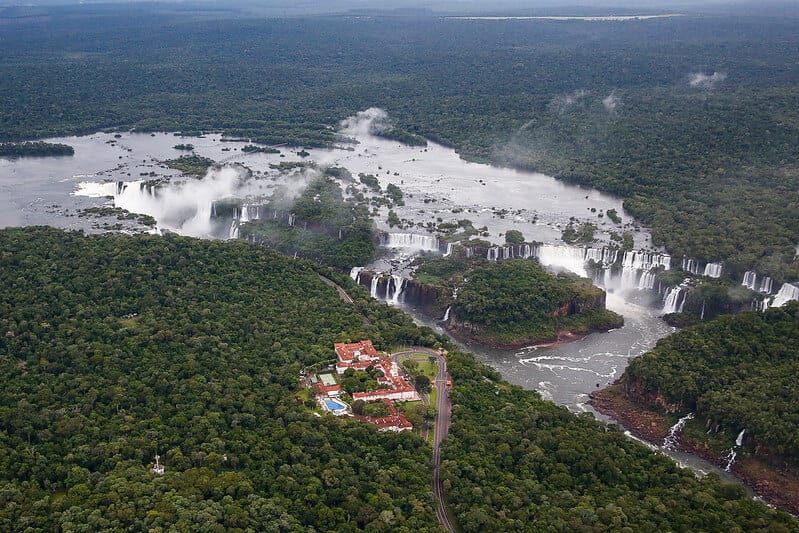
Poço Preto Trail (3-4 Hours) and Banana Tree Trail (1-2 Hours)
The park also offers two trails that are not visited by most tourists, as they are not directly connected to the waterfalls or pass through them. These trails, however, offer a deeper exploration of the park’s wildlife.
One is the Poço Preto Trail, ideal for nature lovers and hikers. This 9 km (5.6 miles) trail can be explored on foot or by bike and takes you through the heart of the Atlantic Rainforest, where you’ll have the chance to see a variety of bird species, butterflies, and perhaps even some larger animals.
The Banana Tree Trail (Trilha das Bananeiras) is a shorter, easier hike through the rainforest. It is about 1.5 km (0.9 miles) long and takes you through a banana grove, offering visitors an introduction to the local flora. The trail ends at a scenic spot on the river and can be accessed on foot or by bicycle.
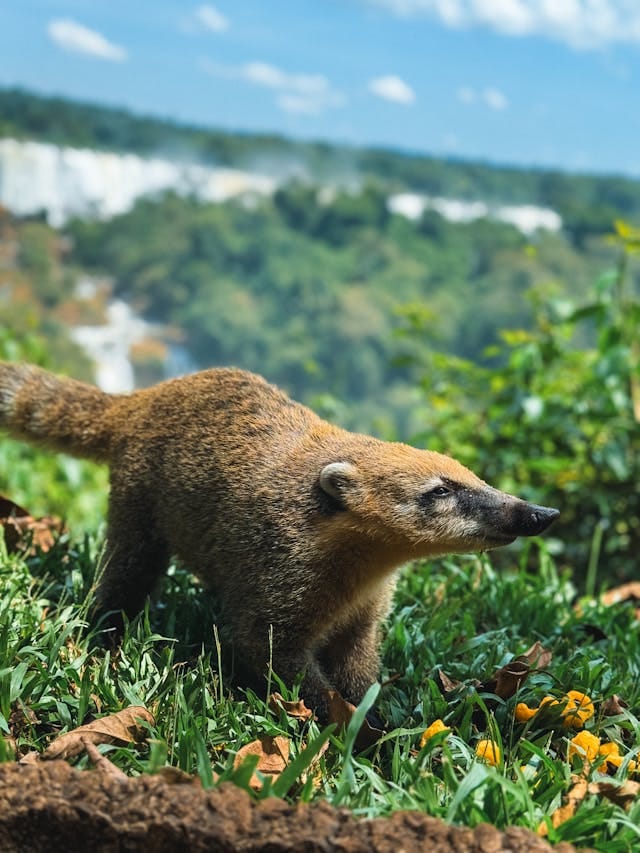
Lunch at Porto Canoas Restaurant (1 Hour)
Located inside Iguaçu National Park, at the end of the main trail, the Porto Canoas Restaurant offers a dining experience with a view of the Iguazu River. The restaurant serves a buffet of Brazilian cuisine, including local dishes, and provides an opportunity to enjoy the natural surroundings while having a meal.
Bird Park (1.5-2 Hours)
Right next to the entrance of Iguaçu National Park is the Parque das Aves (Bird Park), home to over 1,300 birds from 150 different species. You can wander through immersive walkways that bring you face-to-face with macaws, toucans, and many other colorful species. The park is also home to butterflies, reptiles, and small mammals, offering an opportunity to experience the region’s biodiversity.
In addition to the basic visit, many tourists combine the Macuco Safari, lunch at Porto Canoas, and a visit to the Bird Park in their itinerary. Those who want to explore more of the park and immerse themselves in nature often include the Banana Tree and Poço Preto Trails as well.

Exclusive activities
The park also offers exclusive activities, such as:
- Sunrise at the Falls: This special experience allows visitors to enjoy the sunrise over the falls and have breakfast at Porto Canoas Restaurant. It is held on scheduled days.
- Sunset at the Falls: This includes entry after the park closes, allowing you to enjoy the sunset. Guests are welcomed with live music and a celebratory toast with sparkling wine, water, and juice options. It takes place every Tuesday, Friday, and Saturday.
- Night at the Falls: This experience provides breathtaking views of the falls under a full moon and starry sky. It includes entry after the park closes and a Pasta Dinner at Porto Canoas Restaurant. It is held every Saturday.
- Picnic at the Falls: An outdoor meal experience, this picnic includes a kit for two people set up on the lawn of Santos Dumont Square, offering a unique view of the Iguazu River and the stunning Iguazu Falls. The picnic runs from 11 AM to 3 PM.
These activities offer unique ways to explore and enjoy the natural beauty of Iguazu Falls outside of the regular park hours, creating unforgettable experiences for visitors.
Additional Nature Experiences
- Macuco Selva: For a deeper immersion in nature, there’s also the Macuco Selva, which follows the same route as the Macuco Safari but without the boat ride. This tour can be done every day.
- Macuco Safari or Selva + Waterfall Rappelling: In addition to the activities included in the Macuco Safari or Macuco Selva, you can also experience waterfall rappelling. This involves descending 20 meters (65 feet) by rappel down the Salto Macuco, a waterfall that flows from ancient rocks in the heart of the forest. This tour is also available daily.
- Bike Poço Preto: A guided bike tour that offers a complete, comfortable, and informative ride along the Poço Preto Trail. These tours are available daily.
Of all the activities described above, only the basic visit to the park and the Poço Preto and Banana Tree trails are included in the price of the standard park ticket (Cataratas admission). All other activities must be paid for separately.
Argentine Side
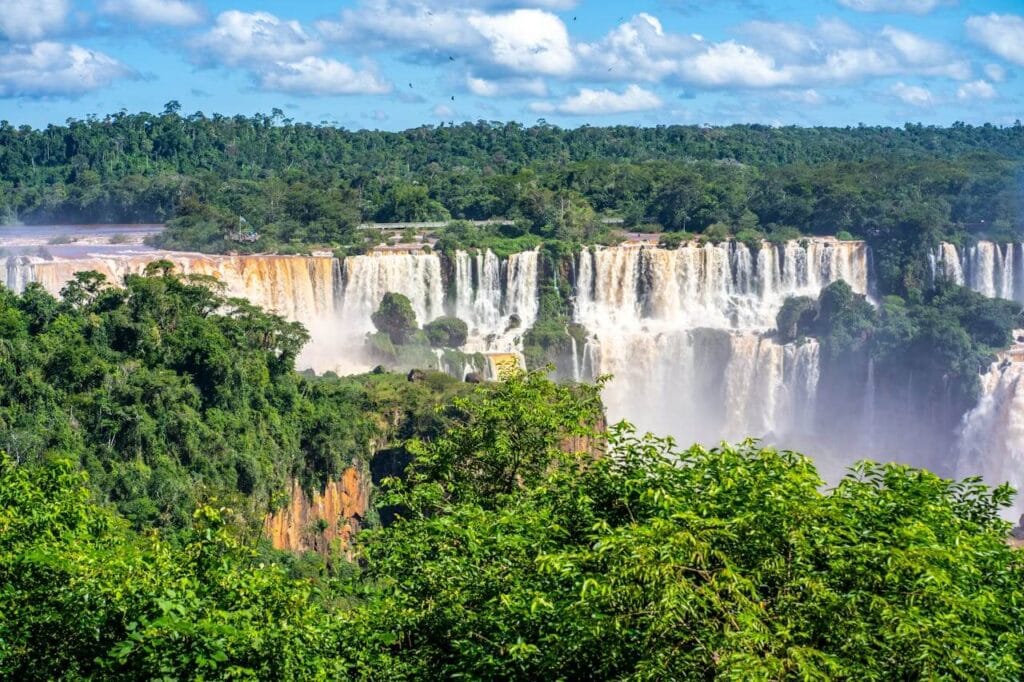
The Argentine side of Iguazu Falls, located within Iguazú National Park, offers a more immersive experience of the falls, as it has more attractions than the Brazilian park.
While the Brazilian side features just one main circuit for visiting the falls, the Argentine side boasts three different circuits, in addition to various other activities and trails that allow visitors to get even closer to the waterfalls and explore the surrounding rainforest.
Here’s a breakdown of all the main activities and their typical durations:
Basic Visit to Iguazú National Park (4.5-6 Hours)
A standard visit to Iguazú National Park typically lasts 4.5 to 6 hours, and includes the following:
- Eco-Train Ride (30 minutes): The Eco-Train is an environmentally friendly way to travel within the park. It connects the park’s entrance to the three main circuits, including the Devil’s Throat. The train ride itself offers views of the park’s rainforest and often includes sightings of local wildlife.
- Lower Circuit (1.5 to 2 hours): The Lower Circuit is a 1,700-meter-long trail that takes you on a network of walkways through vegetation, offering several viewpoints along the way. It brings you closer to the base of several waterfalls, providing an up-close perspective where you can feel the mist. The circuit includes stairs, making it a bit more demanding than other trails, but the experience is incredibly rewarding.
- Upper Circuit (1 to 1.5 hours): The Upper Circuit features elevated walkways along a 1,750-meter-long trail, offering panoramic views from above the falls. The trail takes you over several smaller waterfalls, with breathtaking views of the larger cascades in the distance. This trail is easier than the Lower Circuit, as it has flat walkways and no stairs.
- Devil’s Throat (1.5 to 2 hours – including travel time): The Devil’s Throat is the most iconic and powerful part of Iguazu Falls. To reach the viewing platform, visitors walk along a 1.1 km (0.7 miles) walkway that extends over the river. The round trip, including travel on the Eco-Train and the walk, covers a total distance of 2.2 km (1.4 miles). Once at the platform, you’ll witness the incredible force of the water plunging into a massive gorge, providing one of the most breathtaking views of the falls.
- It’s important to note that the Devil’s Throat walkway, which had been closed for quite some time, was reopened in July 2024.

Great Adventure (2 hours)
The Great Adventure is a boat ride that takes you up the Iguazu River to the base of the falls, similar to the Macuco Safari on the Brazilian side. This tour also includes a 4×4 vehicle ride through the jungle, where you’ll learn about the flora and fauna of the park before heading to the boat.
The boat ride takes you under some of the falls, and getting soaked is part of the fun!
In reality, the Argentine boat tour is much more intense than the Brazilian one. The boats travel at higher speeds, make two stops at different waterfalls (while the Macuco Safari on the Brazilian side makes only one), and get incredibly close to the falls—so close, it can be a bit scary!
There is no “without excitement” option here. Be sure to bring a change of clothes, as you will get completely soaked too (even with a raincoat).
👉 Explore the Argentine side of Iguazu Falls with comfort and adventure — this full-day tour includes hotel pick-up, scenic trails, and a high-adrenaline boat ride into the spray.

Macuco Trail (3 hours) and Green Trail (10 minutes)
The Macuco Trail in Iguazú National Park is a 7 km (4.3 miles) round-trip trail that takes around 3 hours to complete and leads you through the dense Atlantic Rainforest, offering opportunities to spot local wildlife such as monkeys, birds, and small mammals.
The trail ends at the Arrechea Waterfall, a 23-meter-high waterfall that cascades into a natural pool of crystal-clear water, framed by surrounding rocks. While the trail doesn’t lead directly to the main falls, is a great option for nature lovers looking for a peaceful and immersive experience.
The Green Trail is a shorter, more accessible option within the park, perfect for visitors of all ages. Stretching 600 meters (0.4 miles), this flat trail can be completed in 10 minutes. The Green Trail offers a leisurely walk through the forest, where visitors can enjoy the surrounding greenery and spot some local wildlife.
Exclusive Activity – Full Moon Walk
Unlike the Brazilian side, which offers several exclusive activities, the Argentine side provides only the Full Moon Walk as a unique experience. Available only on full moon nights (five per month), this guided tour takes visitors along the Devil’s Throat walkway to see the falls under the moonlight.
The tour begins after the park closes to regular visitors, creating a peaceful and quiet atmosphere as you walk along the elevated trails. The entire walk lasts around 2 hours and 30 minutes and offers three time slots, starting at 7:45 PM, 8:30 PM, and 9:15 PM.
On the park’s official website or Instagram, you can access the calendar with the specific dates for the Full Moon Walk, and reservations can only be made up to 30 days in advance, as that is when the booking becomes available online.
Is it better to see Iguazu Falls from Argentina or Brazil?
The experience of visiting Iguazu Falls varies depending on which side you choose, and both sides offer something unique:
- Brazilian Side: Known for its panoramic views, the Brazilian side offers sweeping vistas that allow you to take in the grandeur of the falls from a distance. One of the highlights is the Devil’s Throat (Garganta do Diabo), where a walkway leads you close to the most powerful part of the falls. An added bonus on the Brazilian side is that you can also see many of the waterfalls located on the Argentine side, providing a broader perspective of the entire waterfall system.
- Argentine Side: The Argentine side provides a more immersive experience, with extensive walking trails that bring you right up close to the falls. It’s perfect for those who want to feel the spray of the water and explore the many trails, such as the Upper, Lower, and Devil’s Throat Circuits, allowing for a deeper connection with the falls.
Verdict:
- If you prefer panoramic views and shorter walks, visit the Brazilian side.
- If you want a more interactive and up-close experience, the Argentine side is for you.
- Ideally, visit both sides to get the full Iguazu experience!
- Each side has its own charm, and together, they offer a complete view of one of the world’s most spectacular natural wonders.

How Many Days Should You Spend at Iguazu Falls?
Brazilian Side
If you’re planning just the basic visit to the Brazilian side, you’ll need about 2 to 3 hours. Adding the Macuco Safari extends your visit to around 5 hours. If you decide to include other activities like the Poço Preto Trail, Banana Tree Trail, Bird Park, and lunch at Porto Canoas, you can easily spend a full day exploring the park.
So, you can plan for half a day to a full day for the Brazilian side. However, if you intend to do other exclusive activities like the Sunrise or Full Moon Walks, you might need to allocate an extra day.
Argentine Side
To visit the three main circuits on the Argentine side, you’ll need about 4.5 to 6 hours. If you add the Great Adventure boat ride, plan for an additional 2 hours. If you’re interested in exploring the Macuco Trail, you’ll likely need another day.
In total, plan for 1 to 2 days for the Argentine side, depending on how thoroughly you want to experience the park.
Summary
Spending 2 to 3 days is ideal for visiting both sides of Iguazu Falls at a relaxed pace, allowing you to fully appreciate all the trails, activities, and breathtaking views without feeling rushed.
Can You Visit Iguazu Falls in One Day?
If you’re only planning to visit one side of Iguazu Falls, it’s absolutely possible to see either the Brazilian or the Argentine side in a single day. Each side has its own highlights and can be explored thoroughly within a few hours.
However, visiting both sides in one day is technically possible but not recommended, as it requires a rushed schedule that doesn’t allow you to fully enjoy each park’s unique attractions.
If you do decide to visit both sides in a day, it’s best to start with the Argentine side, as the park opens earlier. Arrive as soon as it opens and focus on completing the three main circuits (Upper, Lower, and Devil’s Throat) efficiently. After a quick snack or lunch, head over to the Brazilian side.
Aim to reach the Brazilian park by mid-afternoon, where you can do the main circuit and still have time to take in the panoramic views before the park closes.
For this tight schedule, it’s highly recommended to book this guided tour that covers both sides in one day. Relying on public transportation or Uber can be risky, as it might lead to delays and limit the amount of time you have to explore each side.
Planning in advance and having everything organized will help make the most of your visit.
What Are the Entrance Fees for Iguazu Falls?
- Brazilian Side: For foreign visitors, the entrance fee is around BRL 100 (USD 20). Discounts are available for Brazilian residents and citizens of neighboring countries.
- Argentine Side: For foreign visitors, the fee is approximately AR$ 35.000 (USD 35–40), with discounts for Argentine citizens.



